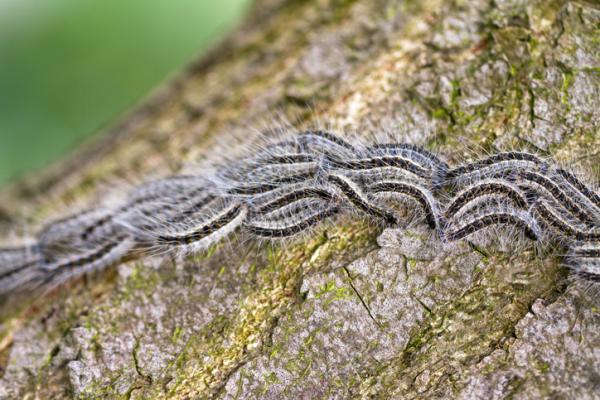Oak processionary moths (OPM) cause damage to oak trees by consuming their foliage. They can also pose a public health risk to both people and animals.
Be alert for oak processionary moths when you are out and about in Surrey Heath. They are mainly present on oak trees but can also settle on other tree species.
Identifying an oak processionary moth
Oak processionary moths are a type of caterpillars . They move in a nose-to-tail processions along the main stems and branches of oak trees or on the ground and often cluster together. They build white, silken webbing trails and nests. These are usually dome or teardrop shaped and are usually found on tree trunks and branches rather than amongst the leaves.

If you spot an oak processionary moth
If you spot an oak processionary moth, do not touch them.
Take a photo if possible and make a note of the location.
Please report any sightings to the Council using the oak processionary moth online form and Forest Research using their Oak Processionary Moth webpage (external link).
Dos and don'ts
Don't:
- touch or approach nests or caterpillars
- let children touch or approach nests or caterpillars
- let animals touch or approach nests or caterpillars
- try removing nests or caterpillars yourself
Do
- teach children not to touch or approach the nests or caterpillars;
- train or restrain pets from touching or approaching them;
- keep horses and livestock a safe distance from infested oak trees. Covering or stabling livestock can help;
- see a pharmacist for relief from skin or eye irritations after suspected OPM contact;
- call NHS 111 or see a doctor if you think you or someone in your care has had a serious allergic reaction;
- consult a vet if you think your pet or livestock has been seriously affected;
- call in a pest control expert to remove infestations in your own trees
More information
For a list of specialist contractors able to remove the nest and caterpillars of oak processionary moth at your own expense, please see the trees.org website (external link).
Tree surgeons, forestry and ground-care workers, and others working on or close to oak trees in the affected areas, should wear full protective clothing, and familiarise themselves with the signs of OPM presence and the regulations applying to handling and moving oak material.
You can also find more information on the Forest Research website:
If you have any questions or need more information please email trees@surreyheath.gov.uk (link sends email).